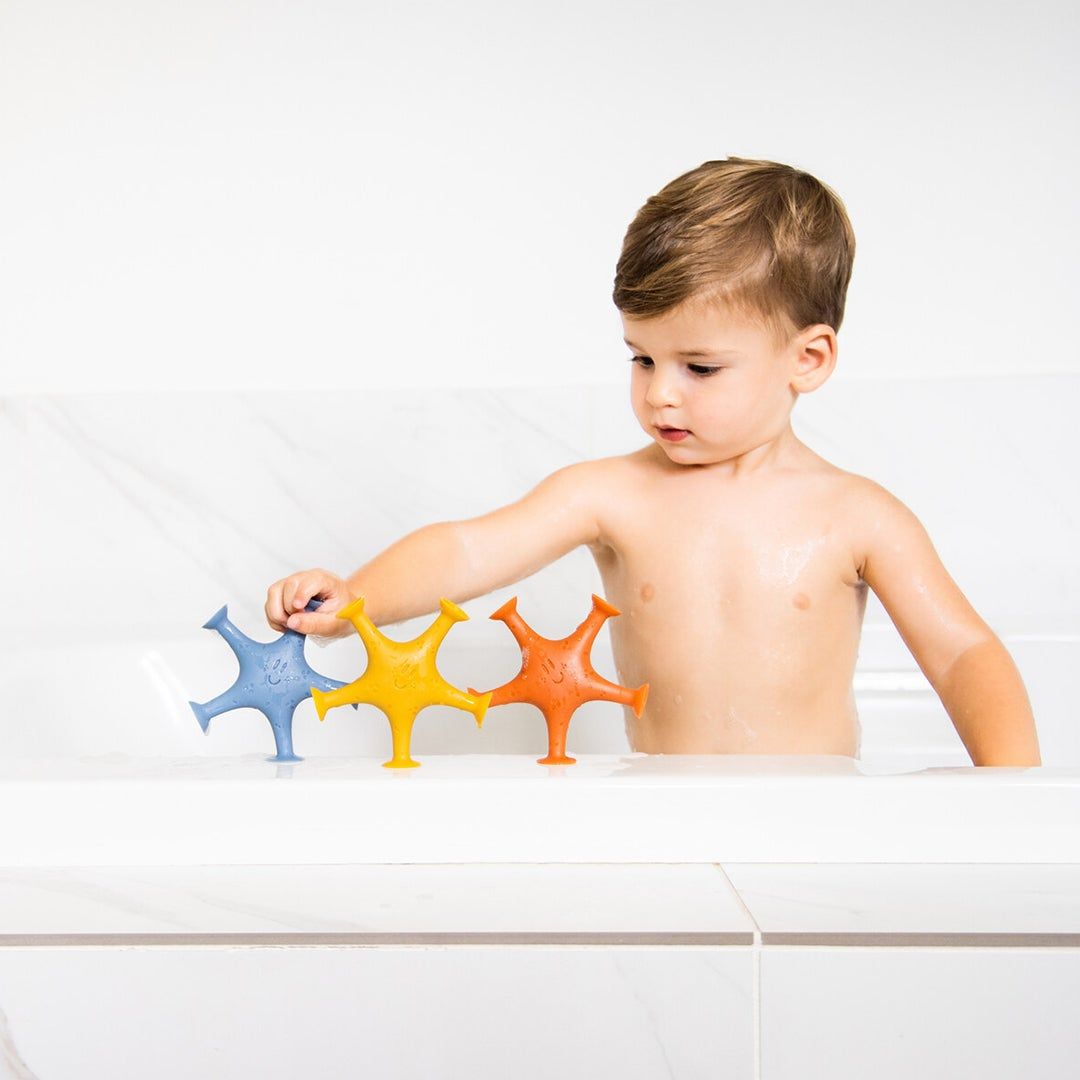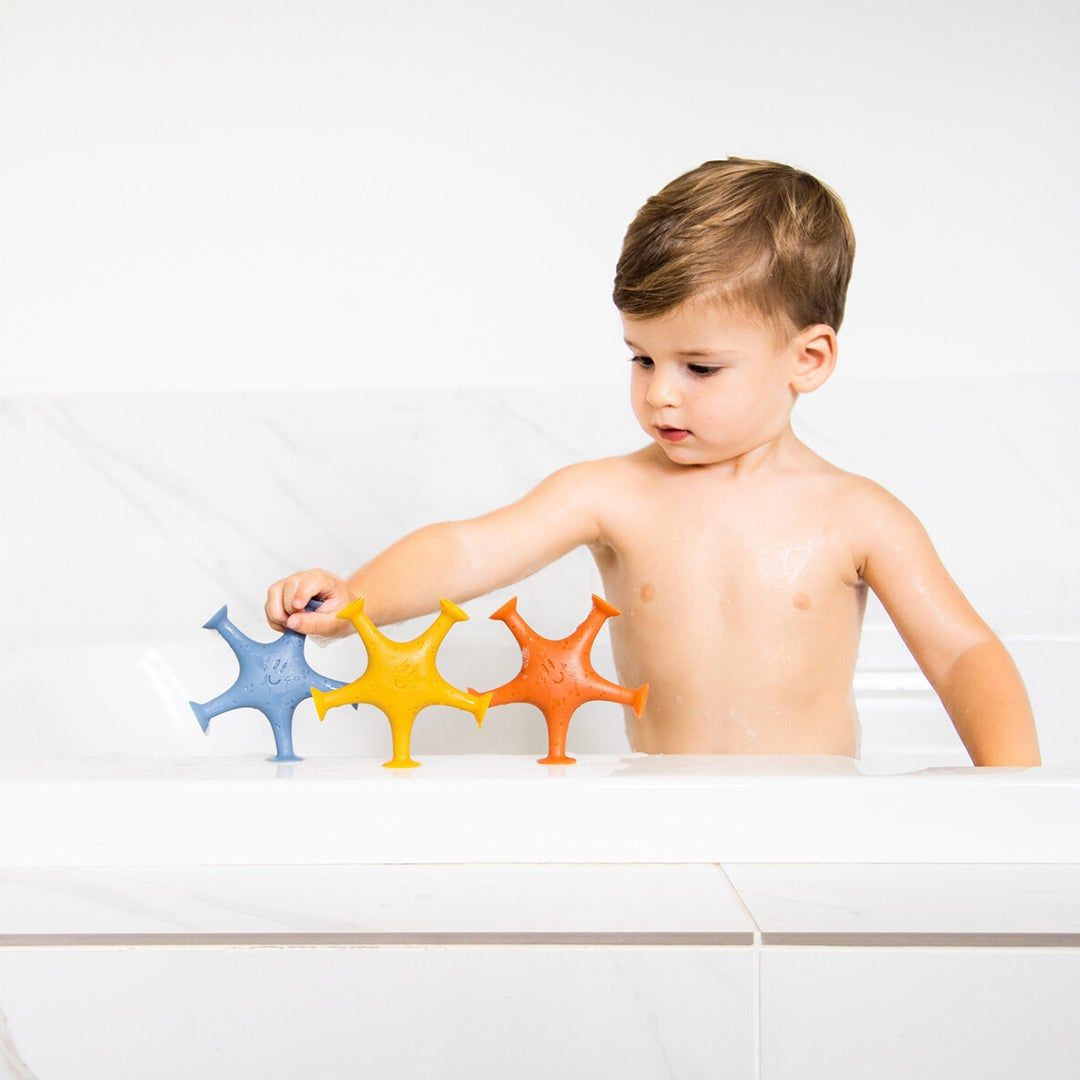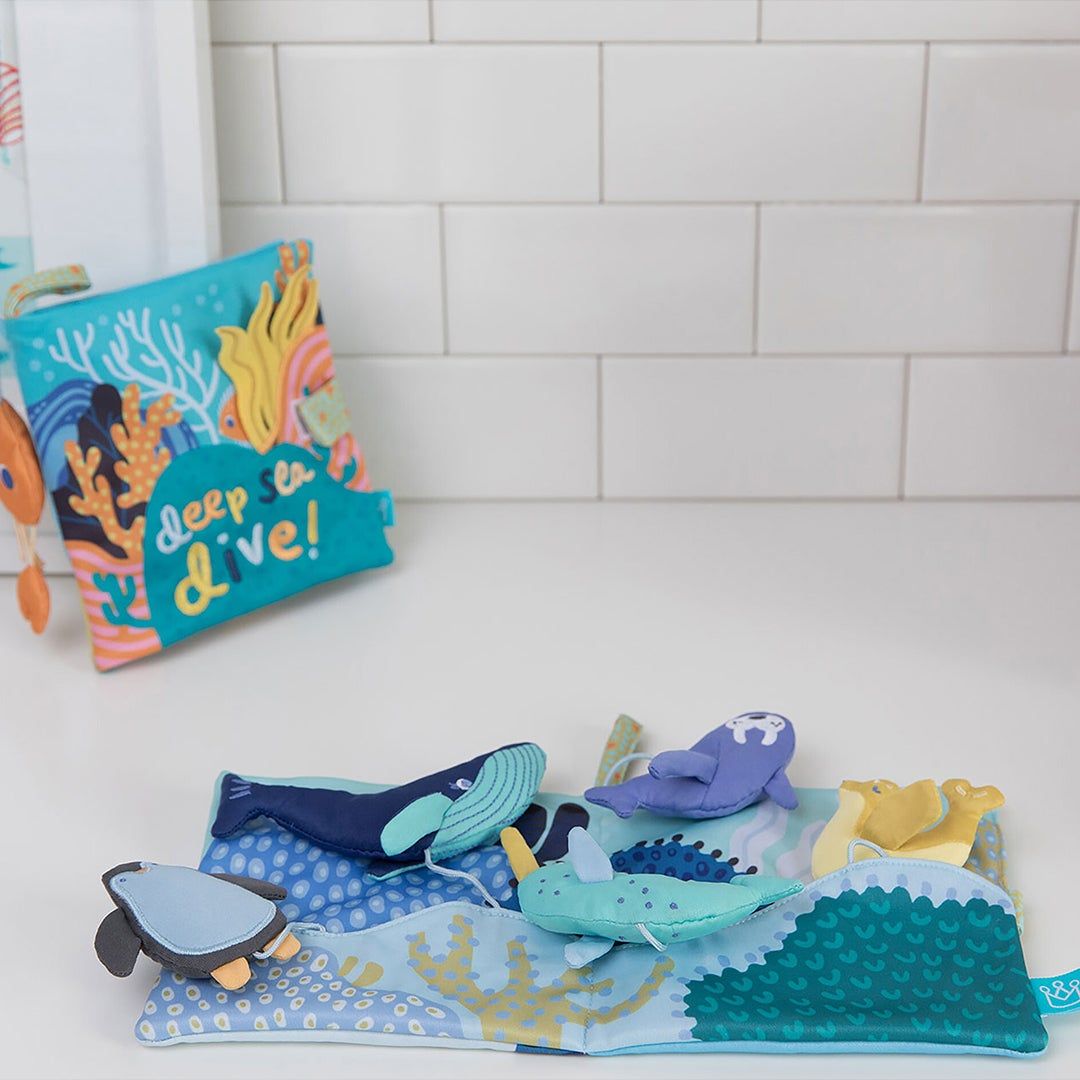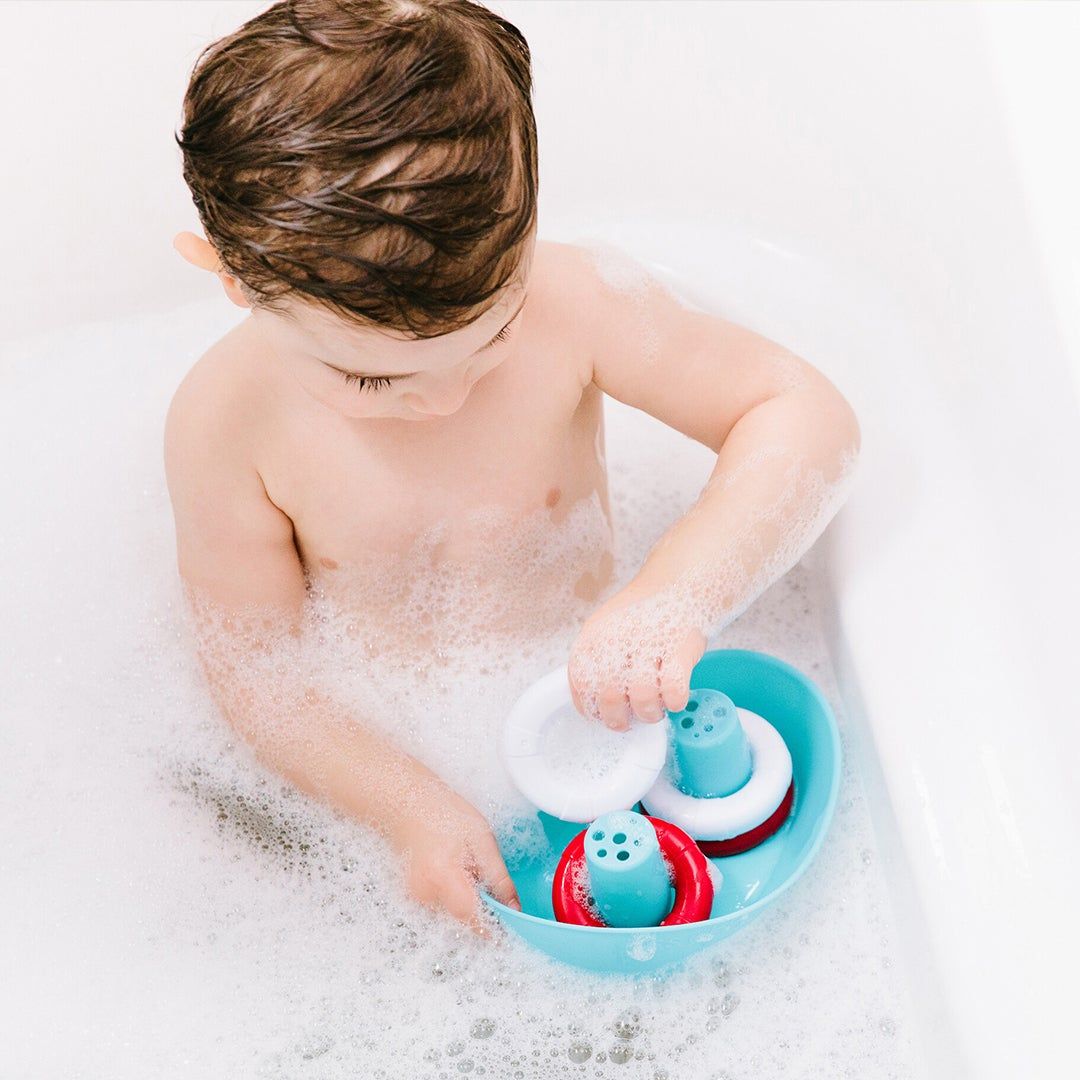
Ugh, Mold: How to Clean Your Child’s Bath Toys
Bath time bad news: your kid's toys probably have mold on them. The good news is that you can easily fix it. Here's how.
- Photography
- Jason Richard
- Written By
- Lauren Finney Harden
We’ve all been there: you go to pick up your child’s bath toy, mid-bath, and you realize there’s mold on it. (Good luck trying to hide that toy from your kid and getting through the rest of the bath!) While some bacteria exposure has been found to be good for your kid, such as building a child’s defenses against asthma and allergies, not all bacteria are created equal. Here’s how to keep bath time squeaky clean fun, including why you need to clean your bath toys, how to clean them, and how to prevent mold.
Why You Should Clean Bath Toys
A 2018 study proved what parents have known anecdotally all along—there is most likely bacteria and or mold lurking on your kid’s toys, particularly bath toys. The study said bathrooms and bathing environments are incubators for bacterial growth, thanks to high moisture and a perfect storm of plastic, soap, and human secretions like sweat. When given the chance, biofilms—aka microbial growth—can thrive on the inside of bath toys, with squeaky toys like rubber ducks being the worst offenders.
The study outlines a parent’s worst nightmare scenario, too: because kids are prone to squeezing toys, they can get all sorts of infections via dirty water squirted—however unintentionally—into their eyes, noses, and mouths. So, while it’s incredibly rare that serious diseases can occur from bath toys, it’s important to take care of and clean them on a regular schedule.
How to Clean Bath Toys
Parents know they need to clean bath toys, but sometimes that task can fall behind things like vacuuming the car seat and cleaning out the humidifier. Here are a few different tactics to clean your child’s bath toys.
Wash with Soap and Warm Water
If you remember, wash bath toys quickly with warm soapy water after each use, and let air dry completely in a well-ventilated area. Anything vessel-like, such as a boat, can be turned on its side or upside down to help prevent standing water where bacteria can grow. Squeeze the water out of anything squishy like a ball. For hard-to-reach spots, like the inside of something cone-shaped, try using an old toothbrush.
Wash with Vinegar or Hydrogen Peroxide
If you want a gentle disinfectant route, try cleaning your toys with either a water-vinegar solution or a water-hydrogen peroxide one. For either, take equal parts water and solution and soak the toys. After 15 minutes of soaking, squeeze or rinse clean and let air dry. Pro tip: keep a dish soap brush filled with vinegar and dish soap in the bathtub. When toys need a little spiffing up, use this to scrub them clean and then air dry well.
Wash with Bleach
If the toys are in a bad way and need heavy-duty disinfecting, you can use bleach. To disinfect with bleach, take ½ cup of bleach to one gallon of water. Submerge the toys and let soak for 10 minutes before thoroughly rinsing with tap water several times, as residual bleach could potentially be harmful to a child. This works best with hard plastic toys that can be rinsed easily, as opposed to soft squeeze toys where bleach can linger.
Run through the Dishwasher
The ultimate parenting hack has got to be the dishwasher. Not all plastic bath toys should go in the dishwasher, though. Check the original packaging or the actual toy to see if the toy is dishwasher safe—that means that it’s a certain grade of plastic and has been tested to withstand the high temperatures and cycles of a dishwasher specifically. To make the most of the toy’s time in the dishwasher, wash it with soapy water before putting it on the top rack. Make sure to thoroughly dry it before storing it. If you have a toy with small pieces or want extra protection, pop them into a lingerie or mesh bag before washing.
Run through the Laundry Machine
If you have a cloth toy, such as a puppet washcloth or cloth book, chances are you can run it through the laundry machine. Check the label or original packaging to see what is recommended. If you want to use the laundry machine but are worried about the spin cycle damaging the toy, try zipping soft toys up in a lingerie or mesh bag. They’ll get clean and stay protected. Air dry well before storing.
When to Toss a Bath Toy
If your child starts to take a shine to a particular bath toy that can get moldy, such as a book or a toy that squirts water, it’s best to go ahead and start thinking about buying backup toys, as chances are, these will have to be replaced at some point. If you’ve tried cleaning them twice or with two different methods and the mold still won’t budge, it’s probably time to give it a toss. Solid plastic toys like boats and cups should typically last as long as your child wants to play with the toy if you take good care to clean them properly.
How to Prevent Mold
Mold occurs more often in a bathroom setting because of all the trapped moisture, and the structure of some toys can make it worse. (Perhaps you’ve heard the horror stories of parents cutting open plastic squeaky toys, only to find the insides riddled with black mold.) Try a drying rack or similar container to help toys breathe, and if you can, hand-dry each toy. If possible, keep the door to the bathroom open to allow the humidity to escape and for good airflow, and consider storing toys somewhere else, such as a hallway or bedroom.
If your child loves a particular toy with a hole—like a rubber duckie, for example—and won’t be bothered by it, try plugging the hole up with hot glue to prevent water from getting inside.
5 EASY TO CLEARN BATH TOYS
Puj Phillup Cups
Sometimes the best toy is the most simple, such as with this Scandinavian-inspired rinse and play cups. They mount to the wall with suction pegs and can inspire tons of imaginative play. Clean them any way you wish— dishwasher, vinegar, bleach, soap and water, or disinfectant wipes—and hand dry.
Shop


Ubbi Starfish Bath Toys
Durable and beautiful, these sticky, stretchy starfish will ignite your child’s imagination. To clean, hand wipe and dry to place them in the top rack of the dishwasher.
Shop


Walter Walrus Scrub-a-Dubbie Washcloth and Bathing Mitt Puppet
One part washcloth and one part lovie, this mitt/puppet is a great friend to help you role play in the bathtub. If he gets a little dirty, he can easily be tossed in the washing machine to make him brand new again.
Shop


Arctic Adventure Soft Bath Time Activity Book
Little bookworms will love this stimulating water-friendly book, which appeals to children from newborns to toddlers. It can be thrown in the washing machine to clean.
Shop


Ubbi Boats & Buoys Bath Toys
Part of a set of nautical-inspired bath toys, this soft-silicone and hard plastic boat set is dishwasher safe and can easily be wiped down with vinegar or disinfectant wipes. It also promotes fine motor skills and hand-eye coordination.
Shop


Lauren Finney Harden
Lauren Finney Harden is a print and digital magazine veteran, having worked on staff and freelance for brands such as Cosmopolitan, Vogue, Byrdie, Verywell Family, Insider, LOFT, Modern Luxury, and Lonely Planet, to name a few. She has also consulted editorially for some of the biggest names in baby gear and clothing. She is a first-time mom to a spirited toddler daughter.